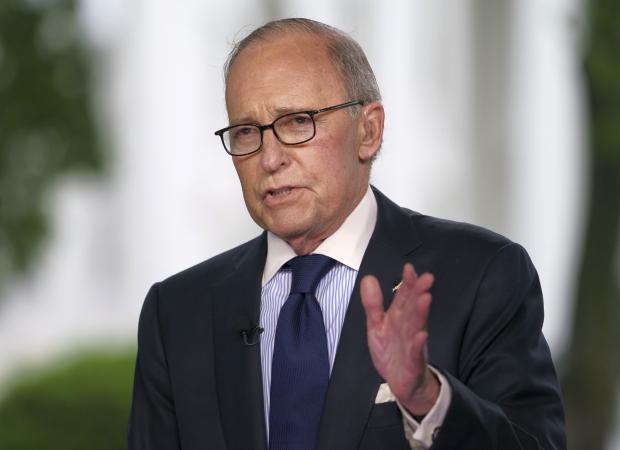
White House chief economic adviser Larry Kudlow speaks during a television interview outside the West Wing of the White House, in Washington, Friday, May 18, 2018. (Photo by CAROLYN KASTER / AP)
WASHINGTON — The United States and China have agreed to take measures to “substantially reduce” America’s massive trade deficit with China, but the Trump administration failed to get the Chinese to commit to a specific numerical goal.
Still, the talks, which began Thursday and ended Saturday with the issuance of a joint statement, may have helped to ease tensions at least slightly between the world’s two biggest economic powers. In recent months the two have threatened to impose punitive tariffs on billions of dollars in each other’s exports.
In the statement, Beijing committed to “significantly increase” its purchases of American goods and services, saying that the increase would “meet the growing consumption needs of the Chinese people and the need for high-quality economic development.”
The two countries also agreed on “meaningful increases” of US agriculture and energy exports and greater efforts to increase trade in manufactured goods and services. The United States said it would send a team to China to work out the details.
The statement, however, provided no dollar amounts on how much China might boost its purchases of American products. Lawrence Kudlow, head of the president’s National Economic Council, had told reporters Friday that a reduction in the trade gap of at least $200 billion by 2020 was a “good number.”
Last year, the United States had a record deficit with China in merchandise trade of $375 billion, the largest with any nation.
Saturday’s statement also was silent on whether the talks had made progress in easing a developing tit-for-tat trade war in which each nation threatened to impose punitive tariffs.
Trade analysts said it was highly unlikely that China would ever agree to a numerical target for cutting the trade gap between the two nations, but they said the talks likely were more successful in de-escalating recent trade tensions.
“It is likely that this agreement, weak and vague though it is, will serve as grounds to at least delay the imposition of tariffs,” said Eswar Prasad, an economist and trade expert at Cornell University.
“The Trump administration seems eager to engineer at minimum a temporary peace with China to ensure a smooth runup to the Kim-Trump summit in June,” Prasad said, referring to the June 12 meeting between President Donald Trump and North Korea’s leader.
The Washington talks, which followed a high-level meeting last month in Beijing, were led on the Chinese side by Vice Premier Liu He and on the American side by Treasury Secretary Steven Mnuchin. The US delegation included Commerce Secretary Wilbur Ross and US Trade Representative Robert Lighthizer.
Trump campaigned in 2016 on a pledge to get tough on China and other US trading partners. He views the massive US trade deficit with China as evidence that Beijing is engaged in abusive trading practices and has outmaneuvered previous US administrations.
Last August, Lighthizer began an investigation into Beijing’s strong-arm tactics to challenge U.S. technological dominance. These include outright cybertheft of U.S. companies’ trade secrets and China’s demands that American corporations hand over technology in exchange for access to the Chinese markets.
Last month, the administration proposed tariffs on $50 billion of Chinese imports to protest the forced technology transfers. Trump later ordered Lighthizer to seek up to an additional $100 billion in Chinese products to tax.
China responded by targeting $50 billion in US products, including soybeans – a shot at Trump supporters in America’s heartland. The prospect of an escalating trade war has shaken financial markets and alarmed business leaders.
In a separate controversy, the Commerce Department last month blocked China’s ZTE Corp. from importing American components for seven years, accusing the telecommunications company of misleading US regulators after it settled charges last year of violating sanctions against Iran and North Korea.
The ban amounted to a death sentence for ZTE, which relies heavily on US parts, and the company announced that it was halting operations.
A week ago, Trump tweeted that he was working with Chinese President Xi Jinping to put ZTE “back in business, fast.” Media reports suggested that the US was offering to swap a ZTE rescue for an end to proposed Chinese tariffs on US farm products.